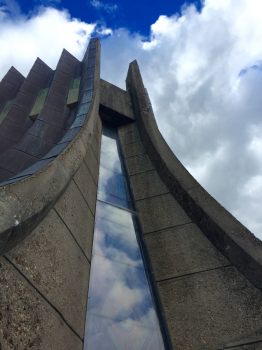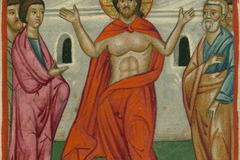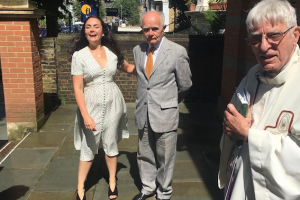Five Catholic churches awarded Christmas funding for urgent repairs

Our Ladys, KItt's Green
Five Roman Catholic churches have received a Christmas funding boost for urgent repairs. They range from a pioneering 1960's church in Birmingham built of glass and concrete; three 19th century churches and one built on the 1930s. A total of 36 churches and chapels in England, Wales, Scotland and Northern Ireland will share in a grants pay-out of £595,000 from the National Churches Trust, the UK's church support charity. Eleven of the churches being helped are on the Historic England 'At Risk' Register.
The funding will help pay for urgent roof and other structural repairs and for the installation of kitchens and toilets to allow churches to be used for community activities. Top of the 2016 list of funding requests received by the charity include repairs to roofs, stonework and drainage and the provision of toilets and kitchens.
The National Churches Trust is a charity which supports church buildings of all Christian traditions and the latest grants benefit Church of England, Roman Catholic, Church in Wales, Methodist, United Reformed and Presbyterian places of worship.
Huw Edwards, Vice President of The National Churches Trust said: "I'm delighted that this Christmas the future of 36 UK churches and chapels is being safeguarded thanks to a £596,000 rescue package from the National Churches Trust. The funding will help ensure that more churches and chapels can continue to flourish at the heart of their communities by safeguarding their architecture and making sure their facilities are up to date."
"At the heart of the nation's history, churches and chapels are some of the UK's best loved local buildings. But their future is not guaranteed. When people visit a church or chapel for a carol service or even just walk past a church on the way to do the Christmas shopping, I urge them to think about how they can help ensure that churches can remain open and in good repair."
"Everyone can make a contribution to the future of the UK's churches and chapels by volunteering to help look after these precious buildings. If you've got practical skills you could help clear drains and gutters, if you are a good communicator you could help show people the history and architecture of a local church or you could simply be a good neighbour and keep an eye out for vandals or thieves."
"Churches and chapels may be historic buildings, but they can be part of our future, too."
ROMAN CATHOLIC CHURCHES RECEIVING FUNDING
BIRMINGHAM
St Patrick's, Dudley Road B18 7QN
Awarded a £20,000 National Churches Trust Repair Grant to help fund a project to carry out repairs to the Nave and North aisle roof and to stonework and to replace rainwater goods. The roof and rainwater goods are the 1890s originals and have gone far beyond their useful life.
The repairs to the roof will secure the future of this church and ensure that it continues to serve an important role in the community, especially for visitors and patients of the nearby hospital.
St Patrick's Roman Catholic Church is a large, Gothic style building, built in red brick. Designed by Dempster & Heaton of Birmingham, the church was built by respected local firm John Bowen & Sons who later went on to build the Victorian Law Courts, Edgbaston Assembly Rooms and the Birmingham Meat Market. The church opened in 1895.
The interior in particular is of high quality and richly furnished. At the east end of the chancel is an elaborate high altar and reredos. The altar is stone, alabaster and coloured marble with a carved panel of the 'pelican in her peity' at its centre. The reredos is carved stone relief panels, angels and crocket details. The sanctuary floor is paved with a mixture of modern marble and historic Minton tiles.
Due to many parishioners being shift workers from the hospital, the building is open as early and as late as possible to accommodate their needs. The church is used by a wide range of local, vibrant and diverse groups, including Vietnamese, Filipino and African communities. There is a daily Mass. Due to the church's close proximity to the A&E hospital department, it offers a valuable place for anybody needing a place of quiet reflection, in particular those who are grieving the loss of a loved one.
Our Lady Help of Christians, Kitts Green B33 0AU
A National Churches Trust £40,000 Cornerstone Grant to help fund urgent repairs to the roof and to rainwater goods.
Gilbert Scott's Our Lady Help of Christians is a Grade II* church in the centre of Kitts Green, Birmingham. Built in 1966-7, it is described by Historic England's Elain Harwood as "...one of the few churches of the late 1960's to be built with the ambition and panache of the first half of the decade."
Our Lady was built to designs by Richard Gilbert Scott who had inherited the commission from his late uncle Adrian Gilbert Scott. The church was built after the Second Vatican Council to meet the needs of the new liturgy - it is T-shaped on plan, and all members of the congregation sit within 50 feet of the altar. The church was listed Grade II in 1999 and upgraded to II* in March 2016. Gavin Stamp of the C20 Society described it in their '100 Buildings 100 Years' campaign as "one of the most successful modern Roman Catholic churches in England". The church is little altered since its opening.
This year the church is beginning to mark its 50th Jubilee. This building is not only used for worship but as a focal point for the community. The church supports a range of age diverse community groups, with a high proportion of attendees coming from India and the Philippines. There is also a thriving youth group, and activities provided for many older local people who may otherwise be at risk of social isolation. Repairing the church and making it safe and watertight will enable its continued use by the wider community.
When Our Lady was built in 1966-7 it was created from the best materials available at the time; however, as the building was of such an innovative design some of the methods used had never been fully tested and its durability was perhaps a secondary consideration. The combination of glass and concrete have been stressed by external factors such as high rainfall and the building's position directly under the flight path of Birmingham Airport - windows shake when aeroplanes fly over.
LIVERPOOL AND MERSEYSIDE
Ss Peter, Paul and Philomena, New Brighton, CH45 9LT
On the Historic England 'Heritage at Risk' Register. Awarded a £10,000 National Churches Trust Repair Grant to fund urgent repairs to the roof and rainwater of two side chapel areas, which have worsened significantly since they were identified for urgent repairs in 2013. The National Churches Trust has funded two previous phases of work at the church in 2013 and 2015.
A major Wirral landmark, this church's majestic dome is visible from afar. Fr. Thomas Mullins, a determined priest, raised money to build this basilica-like church during the depression, for the fashionable New Brighton seaside resort with its growing Catholic population.
The Sacred Heart Basilica in Lisbon inspired Fr Mullins who engaged E Bower Norris to design the church. Architecturally it owes much to Lutyens' famous unused design for Liverpool Cathedral, evident in the use of brick with spare stone dressings and in the design of the domes.
The church is built in a Roman baroque form, plain nave and high altar of beautiful Italian marbles, reflecting the 1930s fashion for subtle pale greens and creams colours. The Lady Altar has a strong blue lapis lazuli front and the Sacred Heart Altar is fronted with red stone. Fr Mullins brought a number of beautiful C17th Portuguese statues to the church, that of the Virgin Mary being particularly fine.
During the Second World War, sailors returning from Atlantic convoys knew the church as The Dome of Home, signifying safety from German U-boats.
The church was closed in 2008 due to the cost of repairs, but following an enthusiastic local campaign it reopened in 2012 when the Bishop of Shrewsbury established it as a national Shrine Church, cared for by the Institute of Christ the King, an international order of priests.
STAFFORDSHIRE
Sacred Heart Church, Tuntstall, ST6 6EE
Awarded a £10,000 National Churches Trust repair grant to help fund a project to carry out repairs to the roof and rainwater goods and to repoint stonework. The repairs will help realise plans to convert the crypt and encourage wider community use.
The stone fabric of Sacred Heart Church is generally in good condition. However the roofs are deteriorating badly and need urgent work to prevent further water damage to the fine interior which is richly decorated with inlay and mosaic.
Ruth Smeeth MP said: "Repairs will enable this beautiful church to continue being a local focal point serving the public, making a positive contribution to the surrounding community and to the nearby Tunstall Town Centre."
Sacred Heart is a major building in the Tunstall Park Conservation area and as such is at the heart of efforts to regenerate Tunstall town centre. The Tunstall mission started from Cobridge in 1853 in a dual purpose school/chapel dedicated to St Mary. A new church was built in 1869 and remained in use until 1930 when the present church was opened by Archbishop Downey of Liverpool, who described the building as 'a miracle of beauty'.
The architect, JS Brocklesby also designed the nearby St Joseph's, Burslem (which received a £40,000 Cornerstone Grant from the National Churches Trust in December 2015), as well as St Oswald & St Edmund, Ashton-in Makerfield. He was reportedly dismissed by the Parish Priest Fr PJ Ryan, who continued as clerk of works himself, using unemployed parishioners in the construction.
Much of the stained glass and woodcarving was created by young parishioners under the guidance of Gordon Forsyth, Director of the Burslem School of Art. The church was built on a raft foundation to avoid the danger of subsidence. The interior is Romanesque and includes items bought abroad by Fr Ryan. The body of the church consists of three bays, each covered by a dome.
WEST MIDLANDS
St Mary & St John, Wolverhampton, WV2 4AD
On the Historic England 'At Risk Register'. Awarded a £20,000 National Churches Trust repair grant to help fund urgent repairs to stonework.
Following the collapse of high level masonry on buttresses on the west elevation and window surrounds on the west and south elevations, work is urgently required to prevent further loss of fabric and risk to passers-by. The project will preserve the Grade II* listed building for future generations, address the issues of interior damage to the fabric of the building caused by water penetration, whilst also removing the church from the Heritage at Risk register.
St. Mary and St. John, situated in a deprived area of Wolverhampton, is a fine example of a mid-Victorian Catholic church. It is particularly notable for its rich interior. Designed by Charles Hansom and built between 1851 and 1855, the main force behind the building of the church was John Hawksford, who later became Wolverhampton's first Catholic mayor.
The work was carried out by Wolverhampton builder, Richard Wullen. The church's construction unfortunately coincided with the Crimean War, which led to delays and increased costs. The stone used from a local quarry was untested as a building material and the industrial atmosphere of the time played havoc with the fabric of the church. The poor quality of the stone revealed itself in flaking masonry and general decay. In 1907 it was rendered to prevent further deterioration with what was thought to be 'Metallic Cement'. This was removed in the 1990s due to how porous it is. When analysed it was found to be 'Sorel Cement', an artificial stone.




















